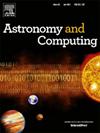DCAPPSO: A novel approach for inverting asteroid rotational properties with applications to DAMIT and Tianwen-2 target asteroid
IF 1.8
4区 物理与天体物理
Q2 ASTRONOMY & ASTROPHYSICS
引用次数: 0
Abstract
This paper introduces the Dynamic Coefficient Adjustment in Parallel Particle Swarm Optimization (DCAPPSO) algorithm for inverting asteroid rotational properties from lightcurve data. DCAPPSO integrates a Cellinoid shape model with Particle Swarm Optimization (PSO), dynamic coefficient adjustment, and parallel computing, offering improved efficiency and accuracy in asteroid parameter determination. The algorithm’s performance was evaluated using simulated asteroid lightcurves and applied to 24 real asteroids from the DAMIT database, including a detailed case study of asteroid (44)Nysa and an additional discussion of asteroid (433)Eros. Results show excellent consistency with established rotational periods, with uncertainties typically ranging from ± 0.000018 to ± 0.009981 h. Pole orientation determinations demonstrate good agreement, particularly for latitude components. The algorithm’s parallel implementation achieves a speedup of 48.617x with 100 workers on multicore CPUs. DCAPPSO was also applied to asteroid (469219) Kamo’oalewa, the Tianwen-2 mission target, providing new insights into its shape and rotational properties. For Kamo’oalewa, the algorithm derived a rotational period of (27.63 min) and a pole orientation of . Uncertainty analysis yielded estimates of for pole longitude, for pole latitude, and 0.466017 ± 0.006090 h for the rotational period. Shape analysis indicates a moderately elongated form with axis ratios and . This research advances asteroid inversion techniques, offering an efficient tool to address increasing observational data volumes in planetary science.
DCAPPSO:一种反演小行星旋转特性的新方法及其在DAMIT和天文2号目标小行星上的应用
介绍了利用平行粒子群算法(DCAPPSO)从光曲线数据反演小行星旋转特性的动态系数调整方法。DCAPPSO将Cellinoid形状模型与粒子群优化(Particle Swarm Optimization, PSO)、动态系数调整和并行计算相结合,提高了小行星参数确定的效率和精度。利用模拟的小行星光曲线对该算法的性能进行了评估,并将其应用于DAMIT数据库中的24颗真实小行星,包括小行星(44)Nysa的详细案例研究和小行星(433)Eros的额外讨论。结果显示与已建立的旋转周期非常一致,不确定度通常在±0.000018至±0.009981 h之间。极位测定结果显示出很好的一致性,特别是对于纬度分量。该算法的并行实现在多核cpu上实现了48.617倍的加速。DCAPPSO还应用于小行星(469219)Kamo 'oalewa,这是“天文2号”的任务目标,为其形状和旋转特性提供了新的见解。对于Kamo’oalewa,该算法得到的旋转周期为0.460510h (27.63 min),极向为(134.67°,- 11.39°)。不确定性分析得出极经度为133.52°±0.01°,极纬度为- 10.67°±0.05°,旋转周期为0.466017±0.006090 h。形状分析表明,轴比为b/a≈0.67,c/a≈0.56,呈中等伸长状。这项研究推进了小行星反演技术,为解决行星科学中不断增加的观测数据量提供了有效的工具。
本文章由计算机程序翻译,如有差异,请以英文原文为准。
求助全文
约1分钟内获得全文
求助全文
来源期刊

Astronomy and Computing
ASTRONOMY & ASTROPHYSICSCOMPUTER SCIENCE,-COMPUTER SCIENCE, INTERDISCIPLINARY APPLICATIONS
CiteScore
4.10
自引率
8.00%
发文量
67
期刊介绍:
Astronomy and Computing is a peer-reviewed journal that focuses on the broad area between astronomy, computer science and information technology. The journal aims to publish the work of scientists and (software) engineers in all aspects of astronomical computing, including the collection, analysis, reduction, visualisation, preservation and dissemination of data, and the development of astronomical software and simulations. The journal covers applications for academic computer science techniques to astronomy, as well as novel applications of information technologies within astronomy.
 求助内容:
求助内容: 应助结果提醒方式:
应助结果提醒方式:


